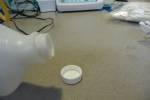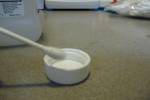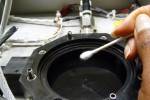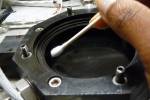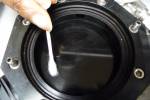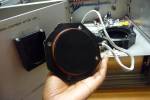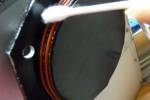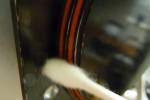Table of Contents
UWYO CCN Counter
- Description: Cloud Condensation Nuclei Counter
- Manafacturer: University of Wyoming Department of Atmsopheric Sciences
- Model Number: 100B
- Serial Number: 112
Problem
On July 23, 2007 flight the CCN concentrations were very low (< 100 #/cm^3). This concentration is not believable for the area sampled.
Cause
On July 25, 2007 it was noticed that the thermocouple wire was shorting out near the top plate. Some times the concentrations were high and sometime they were low, depending on the short in the wire.
Solution
Todd Schulz took the top plate assembly part and fixed the thermocouple connection. The CCN concentrations were much higher on the July 28, 2007 flight.
Operation
1) Wet the pads inside the saturation chamber with distilled water so they are soaked but not dripping with water
2) Close saturation chamber tightly with supplied bolts
3) Connect a serial cable to a computer with ClearTerminal installed
4) Connect coaxial wires to an analog-to-digital board and connect USB cable from board to a computer with TracerDAQ installed
5) Turn red switch on the front of the counter to the ON position and the counter will initialize and automatically start taking measurements when ready
NOTE: Always make sure the on-counter display and the data on the external screen are in agreement, especially when using an analog-to-digital board
NOTE: Re-wet the pads every 2 hours (make sure counter is not taking measurements during this process–see ClearTerminal section)
TracerDAQ Pro
Load TracerDAQ Pro before starting the UWyo Counter
1) Open TracerDAQ Pro
2) Click on Strip Chart to highlight it and click Run
3) A graph will appear and go to File > Load Configuration to load UWyo configuration settings
4) Press the Play symbol to start logging data
- A file is automatically created and new data will be written to it as data comes in
- The current configuration has the channels as follows:
- CH 0: TOPTMP (Top plate temperature)
- CH 1: VDET (Detection voltage)
- CH 2: DTEMP (Change in temperature between top and bottom)
- CH 3: ASTAT (Activity state)
- CH 4: LPWR (Laser power)
- NOTE: The current version of Strip Chart can only take measurements in ~11-hour increments (1 million data points at 25 Hz)
5) When finished, press the Stop symbol and go to File > Save As, click on the .sch file that represents the data taken, change the “Save as type” to (.txt) and click Save
6) Note where the data is saved as you will need to transfer it from the local computer to the network
ClearTerminal
Load ClearTerminal before starting the UWyo counter
1) Go to Connection > New Connection and change the Baud Rate from 115200 to 9600 and click Connect
2) Data will come in automatically via the serial cord and can be run as long as needed
3) When finished, go to File > Save Buffer to File and save the file as a .txt file
To pause counter for re-wetting pads or to reset system in the case of over-saturation:
- CTRL+D pauses counter and brings up menu of options
- 3 and ENTER resets and resumes counter
4) Note where the data is saved as you will need to transfer it from the local computer to the network
How to Clean UWyo CCN Counter
Materials
- Q-tips
- Isopropyl Alcohol
Procedure
- Measure out a capful of Isopropyl alcohol
- Dip q-tip head into the cap and moderately soak.
- Gently swipe q-tip along sides of CCN chamber, being sure to clean all lazer/camera portals.
- Next swipe q-tip along the bottom of the chamber, being sure to clean any seen residue.
- Remove chamber lid from its hook on the CCN door.
- Using fresh soaked q-tip, clean along the sides bearing O-rings.
- When done wait till alcohol to evaporates before operating CCN.
Using m200 Data System
- Turn the m200 on, wait for the system to start up, and insert an 8 mm tape
- Make sure the time on the m200 is correct by typing time and setting new time by typing it in if incorrect; press ENTER if already correct
- Navigate to C:\2012\POLCAST4 and type m200 /rewind
- Make sure there is a space between m200 and rewind!
- Data will start recording to tape
- To quit, type quit and tape will rewind and eject
- See “Processing m200 Data” for processing instructions
Processing m200 Data
1. Insert 8 mm tape from m200 data system into tape drive connected to Lightning
2. Navigate to /data on Lightning and type copy_tape to copy data from tape to Lightning
- When prompted, type n to not skip any files at the beginning
3. While data is copying, open a new terminal and ssh into a computer with access to the airborne network (i.e. radar5) and navigate to the folder where the data will be stored
Example:
/nas/ral/NorthDakota/Summer2014/CliffordHall_423/LabData/date_time/PostProcessing
4. Copy data from Lightning to the path specified above
scp file_name user@location.atmos.und.edu:specified_path
5. Eject tape
6. Process data using process_all script (more info here)
Calibration
In order to calibrate the instrument, we need to have the CPC concentrations and the photo detector voltages in the same file. First, use the “convert_cpc3771tonasa” script on the text file. This will create a CPC raw file that we can work with.
Since the CPC data is 1Hz and the UWyo is every 30 seconds we will next need to average the CPC file for every 30 seconds. Within the CPC directory use the “avgfields” script with points set to 30 for a 30 sec average. No need to fill in any of the other fields. Input file will be the CPC raw file and the output file should be in the form of “CPC3771_YYMMDDavg30sec.raw”.
Since the CPC and UWyo were probably not turned on at the exact same time it is important to find what time the CPC and UWyo started and stopped recording. The UWyo data we are using in this is the file with the format “YY_MM_DD_HH_MM_SS.ccn2_conc.raw” in the PostProcessing directory. It may be necessary to use the “subset” script at this point on one of the files to match the start times up to within 15 seconds. This is so we can successfully merge the files later. When using subset only the start and end times must be filled in. The field section can be filled in to get rid of unnecessary parameters. Input file is avg30sec file and the output file from subset should be in the form of “CPC3771_YYMMDDavg30sec_subset.raw”.
Finally within the PostProcessing directory we will need to use the “mergefield” script to merge our CPC3771_YYMMDDavg30sec_subset.raw file with the YY_MM_DD_HH_MM_SS.ccn2_conc.raw file. The mergefield command should take on this form:
mergefield field=1,2,3,4 target=5,6,7,8 tolerance=15 file=14_11_11_15_52_27.ccn2_conc.raw </path to CPC file/CPC3771_141111avg30sec_subset.raw> 14_11_11_15_52_27.CPC_CCN_ratios.raw
This leaves us with a file containing the UWyo photo detector voltages and the CPC concentrations.
More steps will be added on how to calibrate beyond this point at a later time.
